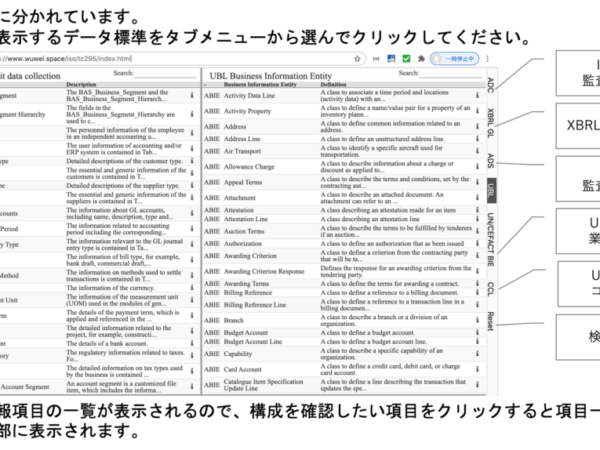Category: Audit data service
-

Study report Part 2 Semantic model definition using ISO/IEC 19505 OMG UML
Views: 12 Study report Part 2 Semantic model definition using ISO/IEC 19505 OMG UML Table of Contents 1. Comments on Part 2 1.1. Draft 4.2.4.2 ACCOUNT SEGMENT 1.2. Attribute not fully listed in Table 3 1.3. The association representation in Table 4 does not follow the UML standard 1.4. Types of association in ISO/IEC 19505 1.5. Multiplicity in ISO/IEC 19505 1.6. Explanation of Multiplicity 2. UML diagram for Account Segment 3. Revised table definition for Account Segment 3.1. Proposed table format change for Part 2 4.1.2 4. ISO 11179:2023 and cardinality of attributes 5. ISO 11179 and cardinality of attributes Nobuyuki SAMBUICHI ISO/TC295 Audit data services/SG1 Semantic model Convener In […]
-

Setting Up Account Segments and Customized Account Segment Tables
Views: 12 Setting Up Account Segments and Customized Account Segment Tables Table of Contents 1. Proposal to Simplify Account Segment and Customized Segment for Ease of Understanding and Efficiency 2. Customized Account Segment and Customized Account Value 2.1. Overview 2.2. Corresponding_File is a predetermined account segment table 2.3. Explaining Corresponding_File as defined in ISO 21378:2019 2.4. Explaining Corresponding_File as a custom table 3. Field Values Used in ISO 21378:2019 Annex B 3.1. General 3.2. The First Set of Records for Account Number 2202 3.3. The Second Set of Records for Account Number 2202 3.4. The third row with Account Number 5502 4. How to setup BAS_Customized_ACC_Segment and BAS_Customized_ACC_Value Nobuyuki SAMBUICHI […]
-

Hierarchical Tidy Data: A Comprehensive Solution for Multi-layer Data Structures
Views: 17 Hierarchical Tidy Data: A Comprehensive Solution for Multi-layer Data Structures Table of Contents 1. Introduction 2. Original Journal Entry 3. Nearly Tidy Data 4. Hierarchical Tidy Data 5. Conclusion 6. Dialogues with ChatGPT Nobuyuki SAMBUICHI ISO/TC295 Audit data services/SG1 Semantic model Convener Following texts are produced by ChatGPT and edited by me. ChatGPT said “As an AI language model, I don’t have feelings or opinions. However, based on our interaction, I hope I’ve been able to provide clear and helpful responses to your questions. We’ve discussed several complex topics, including the principles of tidy data, the challenges of applying these principles to hierarchical data structures, and how hierarchical […]
-

XBRL-GL for Audit Data Collection
Views: 12 XBRL-GL for Audit data collection Table of Contents 1. Mapping between ADC, ADS and XBRL-GL 1.1. Mapping table 1.2. What is the European Triangular currency? 1.3. Bookkeepping in the subsidiary 2. Example instance document 2.1. Sample Journal entries file for XBRL Global Ledger Framework with annotations Version 1.0.91021.1 2.2. Sample Journal entries with timing differences file for XBRL Global Ledger Framework with annotations Version 1.0.91021.1 Nobuyuki SAMBUICHI ISO/TC295 Audit data services/SG1 Semantic model Convener The AICPA (American Institute of Certified Public Accountants) has established a way to connect specific fields in a standard table file with elements in an XML format called XBRL-GL. This is done to facilitate […]
-

Achieving Data Consistency and Clarity in the Table Structure
Views: 11 Achieving Data Consistency and Clarity in the Table Structure Table of Contents 1. Refine Trial Balance Table 2. Missing 4 currency codes 3. How to find out functional currency code? 4. 4 currency codes 5. No.2,3,5 were not improved with your solution Nobuyuki SAMBUICHI ISO/TC295 Audit data services/SG1 Semantic model Convener I recommend the result for 4 currency codes, but it is important in designing a semantic data model to understand what kind of results will be achieved if the model is designed on the premise of normalization. 1. Refine Trial Balance Table User Can you point out the problems with following table definition? PK means the primary […]
-

Shifting Towards Simplicity: Using Single Unique Identifiers in Our Data Model
Views: 10 Shifting Towards Simplicity: Using Single Unique Identifiers in Our Data Model Nobuyuki SAMBUICHI ISO/TC295 Audit data services/SG1 Semantic model Convener In our current table and field definitions, we have several tables that define their primary key as a combination of multiple fields. I recommend that we use a single primary key to define our object classes from our table definition. Primary keys and referenced identifiers (foreign keys) should be defined more simply and clearly in UML associations. User Provide some pros and cons of defining a primary key on multiple fields. Provide the advantage of designing the semantic model of object classes using a single unique identifier (primary […]
-

Extend existing standard or develop our own standard from scratch
Views: 11 Extend existing standard or develop our own standard from scratch Nobuyuki SAMBUICHI ISO/TC295 Audit data services/SG1 Semantic model Convener Model: Default (GPT-3.5) User Is it allowed to extend existiong iso standard to draft new iso standard? ChatGPT Yes, it is possible to extend an existing ISO (International Organization for Standardization) standard to draft a new ISO standard. ISO standards are developed and maintained by technical committees and working groups composed of experts from various industries and organizations. When a need arises to address additional aspects or areas related to an existing ISO standard, a new standard can be developed as an extension or revision of the original standard. […]
-

Why ISO Needs a Framework
Views: 45We cannot allow arbitrary schema definitions. ISO DP2 requires a framework for use by prospective qualified people so that experts can verify that future developments and/or extensions are conformant with the provisions provided in the standard. There is no international standard that has not defined a framework. The data elements and usage may change by jurisdictions and auditors but how to specify requirements on data items shall be provided as a framework.The development of an audit data service standard requires an audit data service semantic model framework. We cannot allow arbitrary schema definitions. It is essential to have a framework on which to determine whether the defined schema is […]
-

A tidy data approach for digital ledgers
Views: 80 A tidy data approach for digital ledgers General Ledger journal entry Consider how to define tidy data for General Ledger journal entry. The following is a journal entry example for purchasing paper with cash. Table 1. General Ledger journal entry Date Line Description Debit (JPY) Credit (JPY) Account Number Account Name C N T ID 2009-04-03 用紙 paper 14,858 754 事務用消耗品費 Office consumables expenses 10 札幌 Sapporo 部門 Business unit 943-8-477 2009-04-03 742 191 仮払消費税等 Temporary payment consumption tax 10 札幌 Sapporo 部門 Business unit 943-8-477 2009-04-03 用紙 paper 15,600 111 現金 Cash 0 共通部門 Common department 部門 Business unit 943-8-477 Key C: Business Segment Code, N: Business […]
-

ISO/TC 295 Audit data services Business Requirement
Views: 93Reduce, Reuse and Recycle is the key concept of SDGs Avoid Not-invented-here syndrome (NIH). NIH can be defined by a tendency for people and organizations to avoid things that they didn’t create themselves. This syndrome is similar to the “let’s reinvent the wheel” syndrome. [SOURCE: https://www.bmc.com/blogs/not-invented-here-syndrome/ ] Business Process Now that we have extended the TC name to audit data services, we should support not only data modeling but also business processes, business rules, and these validation. Extensibility Organizations in each jurisdiction have regulations and / or internal control rules for each jurisdiction. We SHALL supports extensibility to meet these requirements. Comparability There are many things in common other […]
-

ISO Standards for data modeling and business document
Views: 93 ISO ISO 15000-5:2014 Electronic Business Extensible Markup Language (ebXML) — Part 5: Core Components Specification (CCS) ISO/IEC 19845:2015 Information technology — Universal business language version 2.1 (UBL v2.1) ISO/IEC 11179, Information technology — Metadata registries (MDR) Part 3: Registry metamodel and basic attributes Part 4: Formulation of data definitions Part 5: Naming principles Part 6: Registration ISO/IEC 19502:2005(en) Information technology — Meta Object Facility (MOF) ISO/IEC 19763, Information technology — Metamodel framework for interoperability (MFI) Part 10: MFI Core model and basic mapping Part 12: Metamodel for information model registration ISO 20022 Financial services — Universal financial industry message scheme Part 1: Metamodel Part 2: UML profile Part […]
-

How to use the standard data format comparison page
Views: 108[jwplayer player=”2″ playlistid=”3775″] Screen is divided horizontally. Select a standard and click the tab menu to display the configuration.A list of aggregated business information (ABIE) is displayed. Click the item whose configuration you want to check, and the screen that expands the item list will be displayed at the bottom. Note: The response may be delayed and a different item may be selected. Move the cursor over the item and change the line color before clicking. A (+) icon is displayed at the left end of the Association Business Information Entity (ASBIE). Click the row of selected Entity to expand the related Aggregate Business Information Entity. Click the I […]

